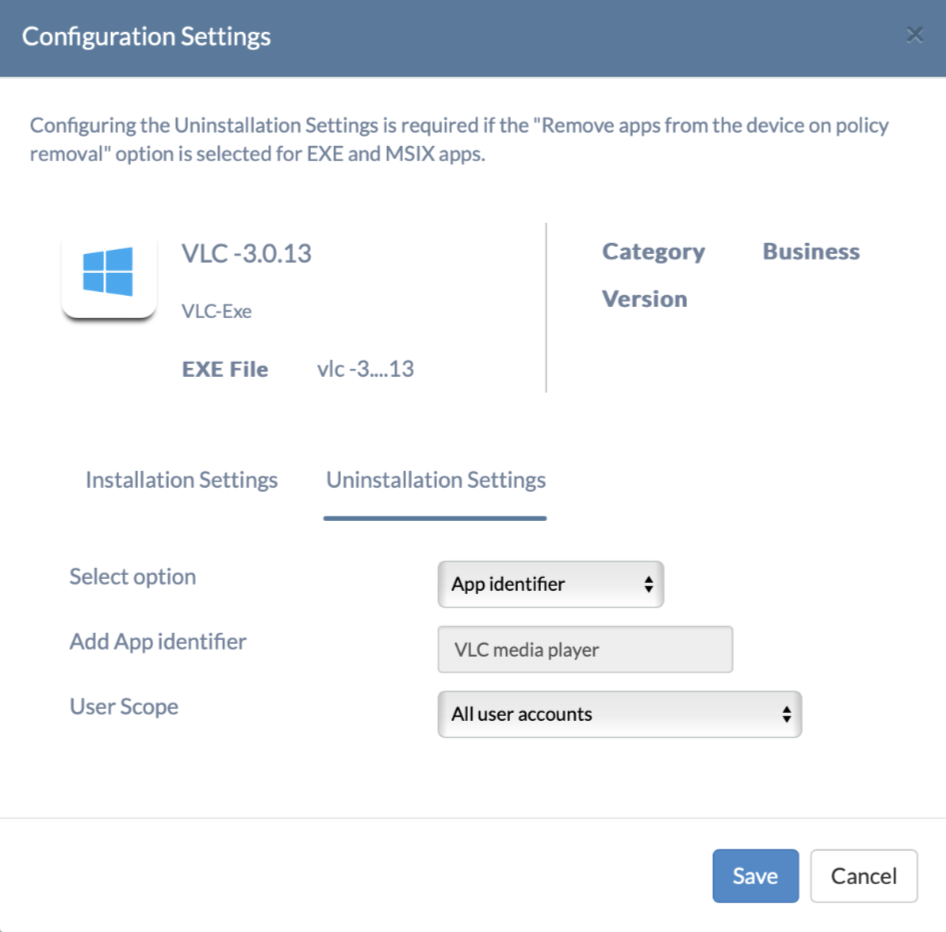Category filter
Deploy Windows EXE apps using Hexnode UEM
Microsoft has introduced the MSI (Microsoft Installer) format to streamline the deployment of enterprise software on Windows systems. However, it’s important to note that a substantial number of software publishers opt not to distribute MSI packages for their applications. Instead, they provide EXE (executable) files for installation on Windows devices. These applications encompass a wide variety, including in-house enterprise apps, utility apps, and various other software types. IT admins can now deploy EXE apps with the help of Hexnode UEM, and this help document explains the step-by-step guide on how to upload, configure, and deploy EXE apps on Windows devices.
Add EXE apps to Hexnode app inventory
An enterprise app must first be uploaded to the Hexnode app inventory before its distribution.
- Log in to your Hexnode UEM portal.
- Navigate to Apps.
- Select +Add Apps > Enterprise App.
- Choose the platform as Windows.
- Provide the App Name.
- Select the app category as EXE File.
- Select an app category or input a new category by clicking on the + button.
- Provide a description for the application and click Add to upload the file.
- Specify the app version for the EXE file.
- While uploading the app file, you can check the Notify admin via email once app upload succeeds/fails option to receive the email notifications on the app upload status.
- Additionally, configure the Success Criteria (at least one is mandatory) and the Uninstallation settings for the app as well.
Success Criteria
Defining a success criterion for installation allows administrators to validate specific app parameters after installation and detect inconsistencies. Success criteria include parameters such as app identifiers, registry paths, and app paths, which confirm whether an app is correctly installed. If the set criteria are met, the app is considered successfully installed, even if discrepancies exist in the enterprise file. Administrators can verify this directly from the console.
Different success criteria:
- App Identifiers: Add one or multiple app/installer identifiers (product codes), separated by a semicolon (;). Once the enterprise app is installed, Hexnode verifies if the installed application contains the specified app identifier. In case of a mismatch, the success criterion will fail.
For example:
The App Identifier may be a string of numbers, or a name provided by the app publisher, such as
{3456C7D8-2345-6789-ABCD-EFG12345678}orMozilla Firefox.
- Registry Path: This option allows you to define the path of a registry key to be checked on the target device. This can be any registry key created when the app is successfully installed. If the key does not match, the success criteria will fail.
There are two components to configure in this option:
- Registry Root: This is the top-level directory in the Windows Registry, such as HKLM (HKEY_LOCAL_MACHINE), HKCU (HKEY_CURRENT_USER), HKCR (HKEY_CLASSES_ROOT), HKCC (HKEY_CURRENT_CONFIG), and HKU (HKEY_USERS).
- Subkey: This is the specific path within the registry root, such as \SOFTWARE\MyCompany\MyApplication.
For example:
In the case of Firefox, the registry key related to the app is ‘HKEY_LOCAL_MACHINE\SOFTWARE\Microsoft\Windows\CurrentVersion\Uninstall\Mozilla Firefox’.
From the registry root dropdown, choose HKLM and enter the subkey ‘
SOFTWARE\Microsoft\Windows\CurrentVersion\Uninstall\Mozilla Firefox‘. - Install Path: This option can be used to confirm the app’s installation on the device by checking for a specific file present on the target device. The file’s location is indicated in the Path field, which should contain the path of any file created upon successful app installation.
For example:
In the case of Mozilla Firefox, the path of the file is most likely to be in the following format:
C:\Program Files\Mozilla Firefox\firefox.exe
- App Identifiers: Add one or multiple app/installer identifiers (product codes), separated by a semicolon (;). Once the enterprise app is installed, Hexnode verifies if the installed application contains the specified app identifier. In case of a mismatch, the success criterion will fail.
-
App Identifier: Enter the app identifier.
- Note that the app identifier cannot be modified or configured from the Required Apps policy.
-
File Path: Provide the exact file path (e.g.,C:\Program Files\Hexnode UEM\uninstall\helper.exe).- If the app requires specific uninstallation commands, check Add uninstallation commands and provide the necessary parameters.
- User Scope: Choose whether the scope applies to All user accounts or the Current user account.
- Click Add to upload the file.
Later, the administrators can select one of these parameters to assign it as the success criteria when deploying an enterprise app to the devices.
Uninstallation settings
You must configure at least one of the following options:
Deploy EXE apps via the Install Application action
The EXE apps added to the Hexnode app inventory can be distributed to the devices using the Install Application remote action. Follow the given steps for the deployment of EXE apps.
- On your Hexnode UEM portal, navigate to Manage > Devices.
- Click on the device.
- On the device summary page, click Actions > Install Application.
- Select the app.
- Click Configure to specify the installation settings.
- Click Install.
Deploy EXE apps via Policy
- On your Hexnode UEM portal, navigate to Policies.
- Create a new policy with the New Policy button or select an existing policy.
- From Windows > App Management, select Required Apps.
- Click on Configure and +Add button to either add an app or a group of apps from the app inventory.
- Select the required app(s) and click Configure under Custom Installation to set up installation and uninstallation settings.
Configure EXE app installation settings
For EXE apps, Hexnode UEM enables administrators to configure various installation settings during app deployment.
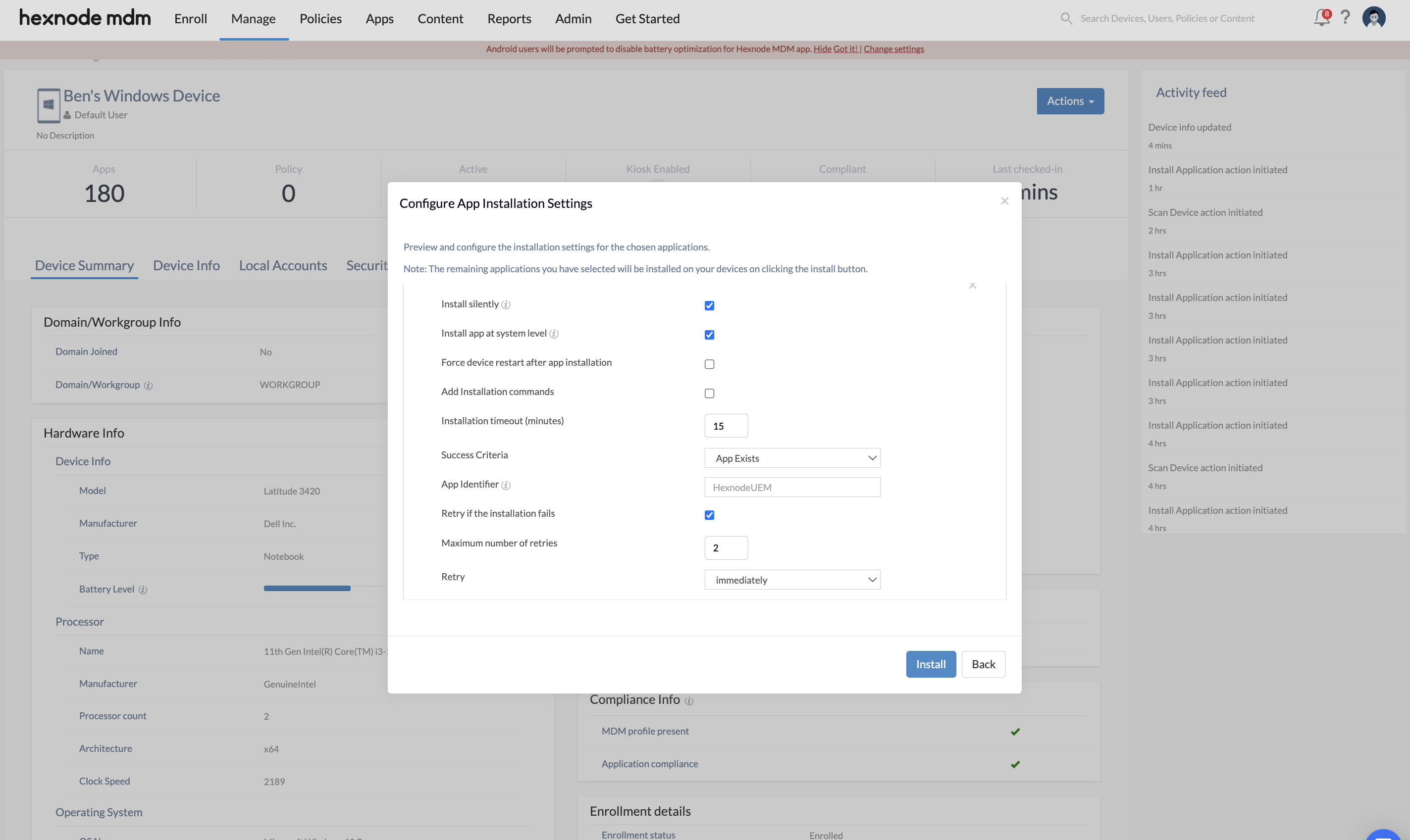
- Install silently: The administrator can install apps silently on Windows devices with the help of this option. By default, this option is enabled, and it allows the installation of applications without prompting the user. If unchecked, the user will get a pop-up to allow the app installation manually.
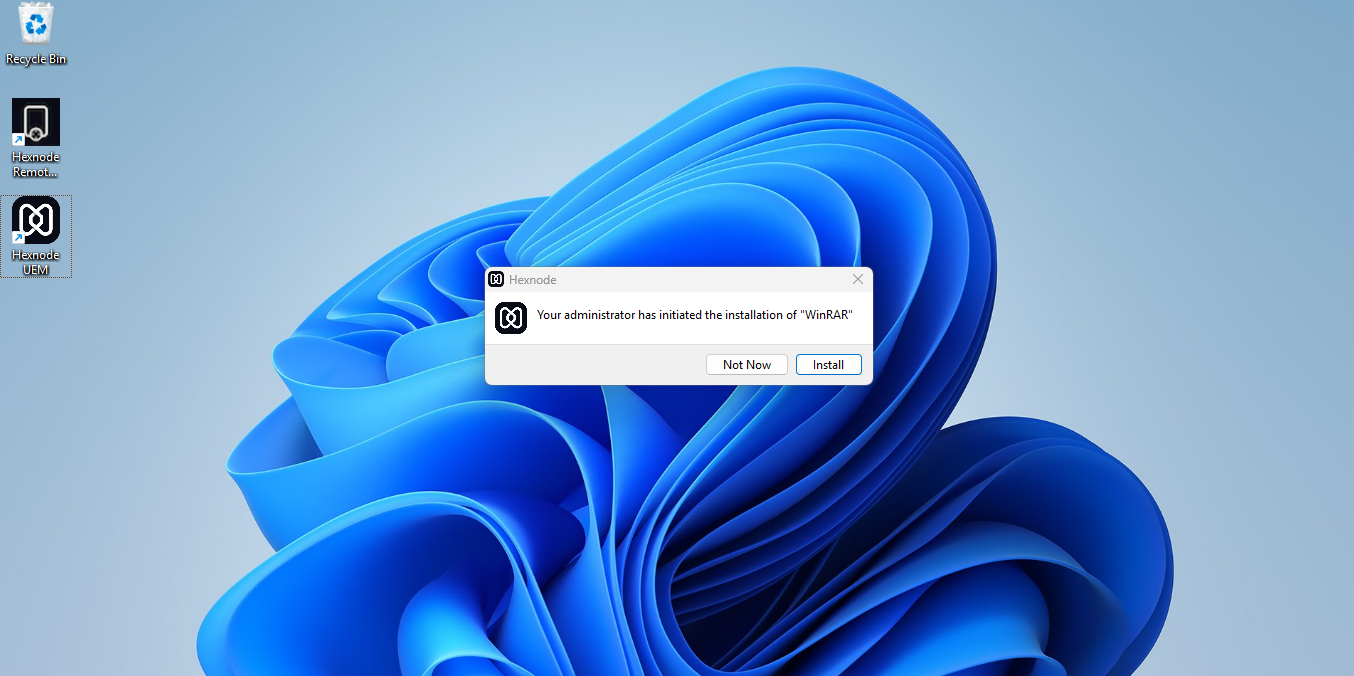
If the user selects the Not Now option from the installation pop-up, then the app installation message will appear under the Notifications section of the Hexnode UEM app. Users can grant permission for installing the app from here in case they selected the Not Now option. This app installation prompt will appear under the Notifications section of the Hexnode UEM app only if the administrator checks the Retry if the installation fails option while configuring the app installation settings.
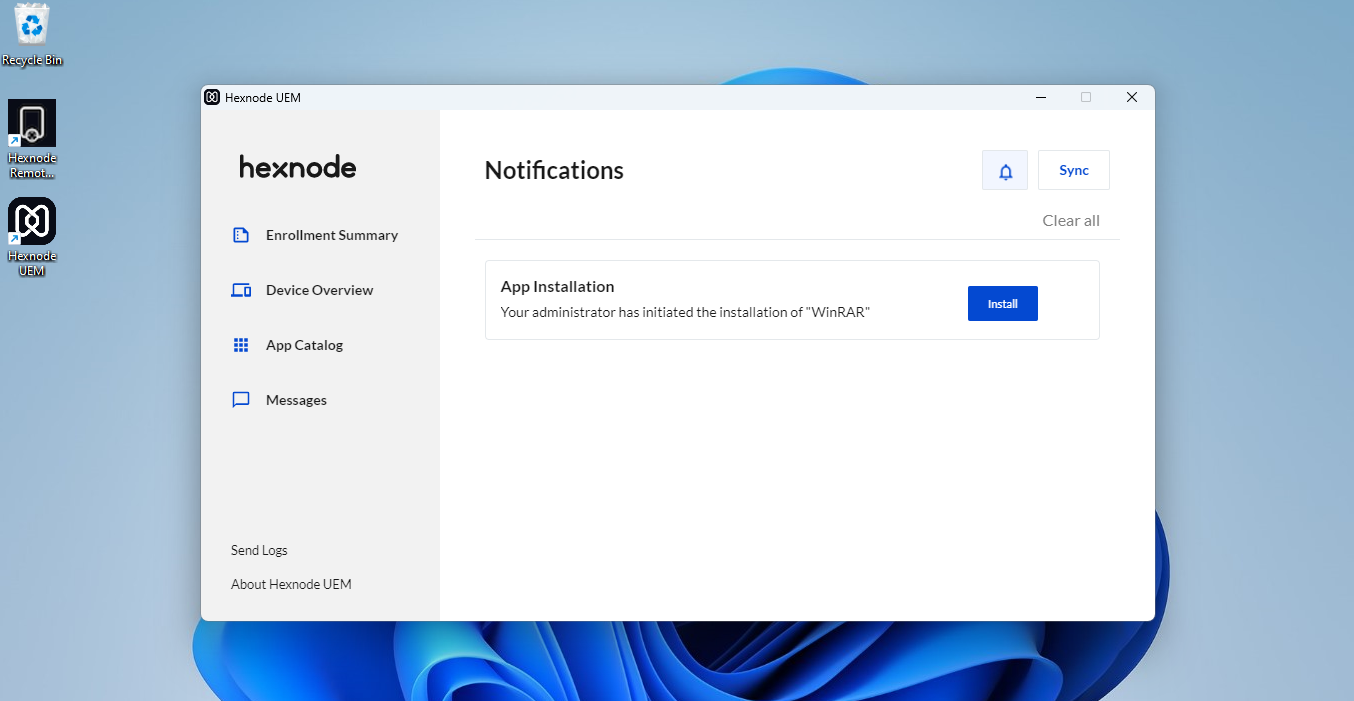
- Install app at system level: Installing an app at the system level refers to making the app available to all users of a computer, rather than just one user. By default, this option is checked. Unchecking this option will lead to the app installation at the currently logged-in user level only.
- Force device restart after app installation: When this option is selected, the device automatically restarts upon successful installation of apps.
- Add Installation commands: Admins can specify installation parameters by checking this option. These command-line parameters help admins modify the installation process and other related operations on the device.
- Installation timeout (minutes): If the app installation process is not complete within the specified time duration, it will be forcefully terminated. The minimum and maximum time duration is 10 and 60 minutes, respectively.
- Success Criteria: You can choose one of the validation criteria defined during the enterprise app upload to the Hexnode app inventory here. The installed application must meet the selected criterion for the installation action to be successful. The three available options are:
- App exists: This option uses the App identifiers parameter as the success criterion.
- Path exists: This option uses the Install path as the success criterion. It can be edited or updated directly from the Installation Settings.
- Registry exists: This option uses the Registry path as the success criterion.
After app deployment, administrators can verify the success criteria status from the Action History tab of the device in the Hexnode portal. Select the app status corresponding to the initiated action to view detailed information.
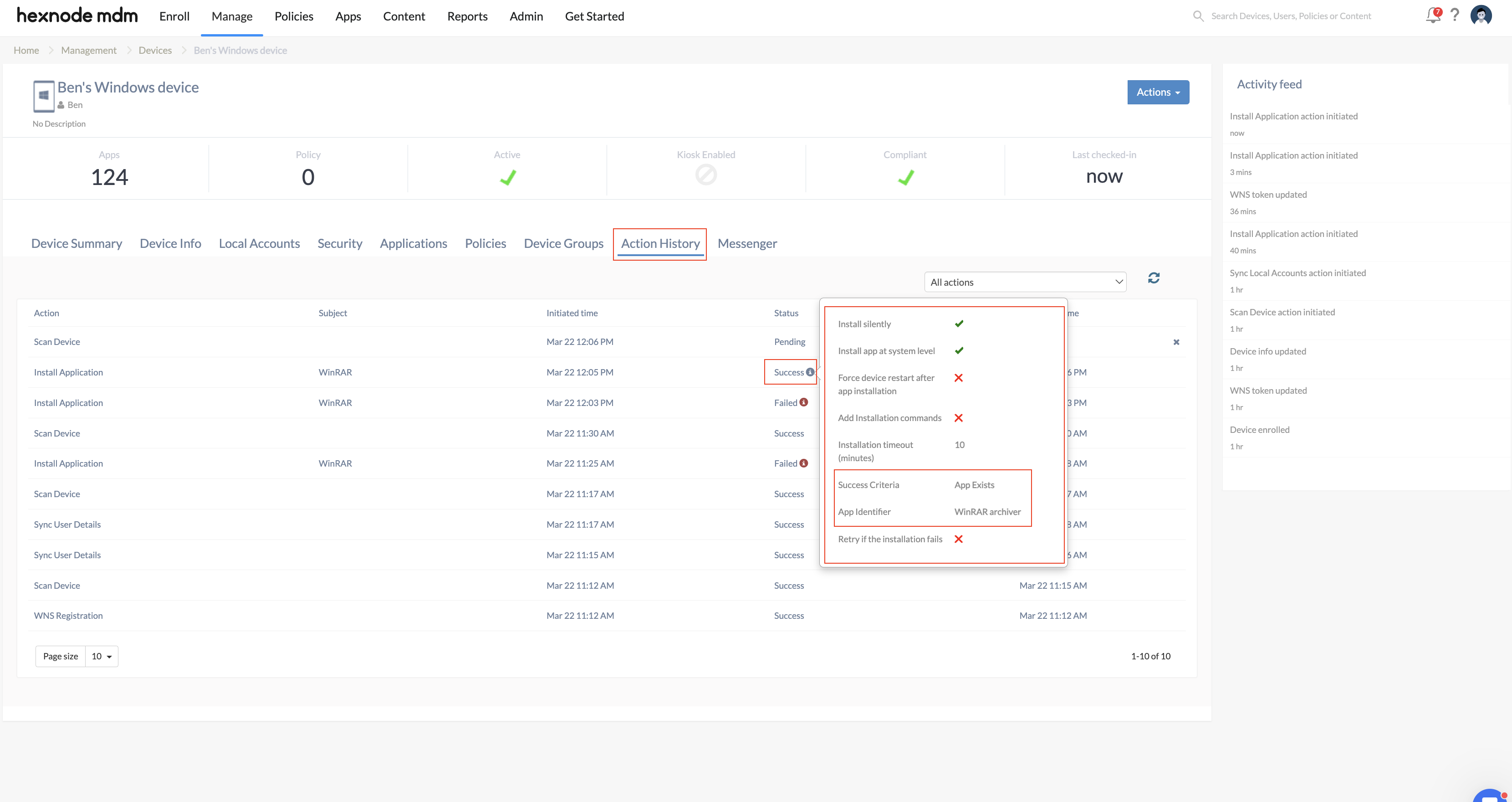
- Retry if the installation fails: This option allows the app installation process to automatically re-attempt if the initial installation attempt fails. The number of tries can be selected from the Maximum number of retries option. The minimum and maximum number of retries are 1 and 5 times, respectively.
- Retry: Administrators can specify when to retry the app installation process. The available options are:
- immediately
- after 1 minute
- after 2 minutes
- after 5 minutes
- after 10 minutes
- after 15 minutes
- after 30 minutes
- after 60 minutes
Configure EXE app uninstallation settings
You must configure at least one of the following options:
-
App Identifier: Enter the app identifier.
- Note that the app identifier cannot be modified or configured from the Required Apps policy.
-
File Path: Provide the exact file path (e.g., C:\Program Files\Hexnode UEM\uninstall\helper.exe).- If the app requires specific uninstallation commands, check Add uninstallation commands and provide the necessary parameters.
- User Scope: Choose whether the scope applies to All user accounts or the Current user account.
- Click Done when finished.
- For EXE apps, configuring the installation and uninstallation settings is mandatory before adding them to Required Apps. These settings can later be edited after adding them.
- Click Save.
- Next, associate the policy with the target devices by navigating to the Policy Targets tab.
- Select the required Devices/Device Groups/Users/User Groups/Domains to which the policy is to be associated.
- Click on Save.
By following the steps mentioned in this help document, IT administrators can seamlessly add EXE apps to the Hexnode app inventory, customize various app installation and uninstallation settings to suit their organization’s requirements, and deploy these applications to devices with ease.
